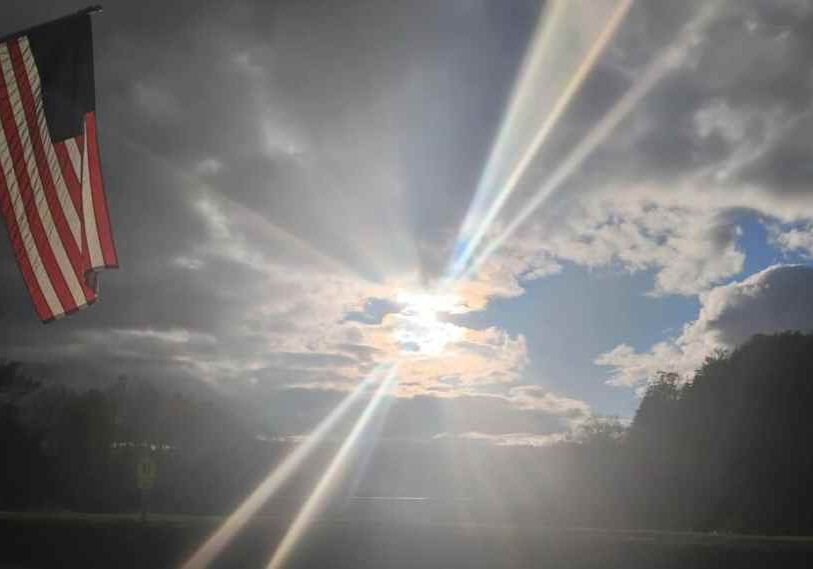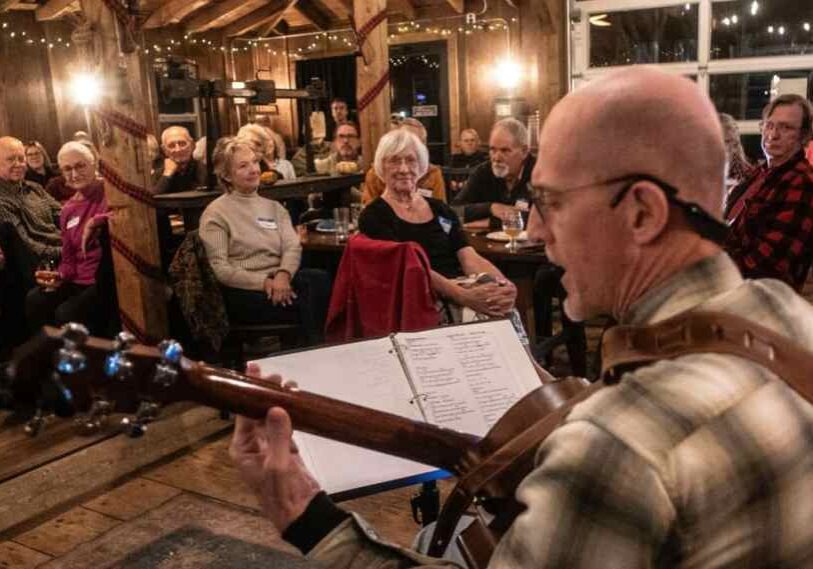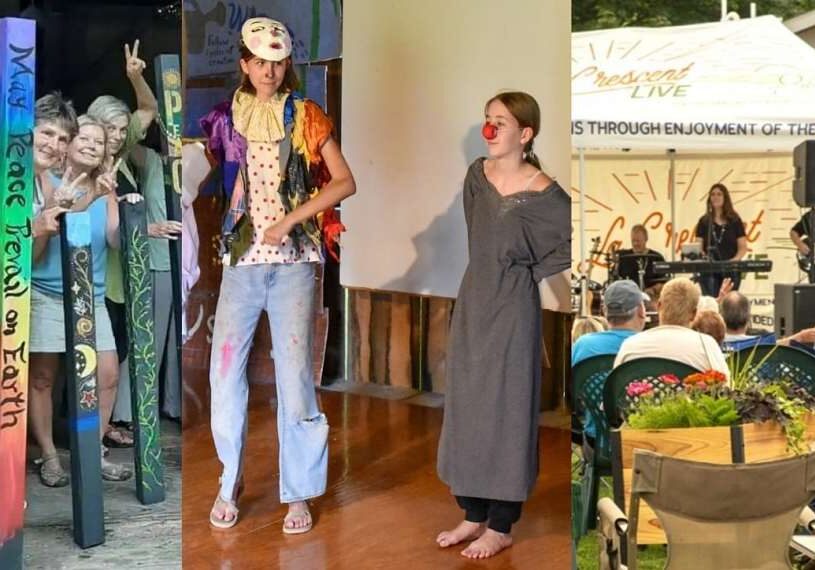Herbjørn Gausta: Norwegian Pioneer and Painter of Church Altars

(Photos by Sharen Haugerud Storhoff)
Celebrating 2025 Regional Arts & Artists
On Saturday, November 15, Root River Current will be “Celebrating Arts & Artists” – profiled artists, content contributors who have written our stories, and others who have published original poems or essays during the year (link to our recent Regional Arts stories).
Our reception will be held from 4-6 p.m. in the Scale Room at Sylvan Brewing in Lanesboro – and you’re invited to join the celebration!
Details and a link to our RSVP page are here. We look forward to seeing you on November 15!
Now, read on to meet yet another artist who is helping to bolster the arts and build community in our region.
FILLMORE COUNTY — Arriving as a child amongst the earliest Norwegian immigrants to America, Herbjørn Gausta rose from poverty and hardship in the new settlement of Greenfield Prairie, Minn., just outside what later became the City of Harmony.
With the support of family and local benefactors, Gausta’s artistic talent and eventual European training ultimately led him to become a notable artist. Yet making a living became tenuous, so he turned to sacred altar paintings for Norwegian churches. He created an estimated 400 inspirational portrayals for this region’s Norwegian churches, which continue to comfort and inspire parishioners to this day.
Unfortunately, Gausta himself was eventually almost forgotten — until local resident Sharen Haugerud Storhoff, whose historic family farm was near the Gausta farm, took an interest in the church altar paintings of local churches and discovered for the rest of us the world of this remarkable artist.
This is Gausta’s story
Born in Telemark, Norway, in 1854, the boy immigrated to Minnesota with his parents and three sisters in 1867, when they settled in the area of Southern Minnesota that had already attracted many other Norwegian immigrants.
Tragedy soon struck the family when his father Niels Gausta died after only two years in country. The fifteen-year-old boy was left with heavy farm responsibilities as the head of the family, along with his mother, Anne, while his sisters hired out to earn money.

The picture of Christ’s Resurrection at Greenfield Lutheran Church in Harmony was painted in 1884. Gausta’s family were founding members of the church.
Even then, Gausta’s creativity was apparent as he drew cartoons, sketches, scenery, people, animals and birds. He managed to attract some support from family and friends.
By age eighteen, Gausta was accepted to the parochial teacher training program at Luther College in Decorah, Iowa. He boarded with local families in town and scrambled for money, not having enough funds for a winter coat, overshoes or art lessons.
Art school in Europe
When Gausta reached age twenty, Reverend Ulrik Wilhelm Koren and other community members realized that Gausta’s focus and exceptional talent was in art, not teaching, and the community found the money — about $100 for his first year — to send Gausta to art school in Oslo, Norway, and later to the Academy of Fine Arts Munich.
There he won the 1878 Munich Academy of Fine Art’s highest medal for his class. He became acquainted with many of Norway’s leading painters and began selling his own realistic nature paintings. Gausta received his diploma after six years of study and painting art in Europe, returning to America in 1881.

Herbjorn Gausta was born in Telemark, Norway in 1854 and immigrated to Minnesota in 1867.
He went on to live for about a year each in the midwestern cities of Chicago, Madison, La Crosse and Decorah, after which he returned to Luther College and the University of Minnesota to teach art.
Gausta finally settled in Minneapolis, where he created his personal art studio on the third floor of the Minneapolis Tribune Building. Yet, within a year, tragedy struck. The entire large brick building burned down, taking everything Gausta had — his furniture, all his own irreplaceable artwork including paintings, sketches, drawings, and photographs, as well as important paintings by his artist friends.
“All that Mr. Gausta has left are the clothes on his back,” wrote the head of the Department of Scandinavian Languages and Literature at the University of Minnesota.
Church altar paintings
Gausta was back to square one at the age of 34, and he had to earn a living. It turned out that Scandinavian patrons in this region were generally not ready to financially support original artwork, other than a few portraits. Despite participating in twenty exhibitions, Gausta had to find another way to survive. He turned to what would become his major art success — producing altar paintings for Norwegian churches.

This church art is in Elstad Lutheran Church near Highland. Gausta generally charged commissions of $75 to $200 for his work.
Gausta had strong personal and professional ties to Norwegian pastors, and some were willing to pay for paintings for their churches. In the end, he produced an estimated 400 altar paintings for churches across the Midwest.
Yet negotiations could be achingly slow. For example, one of his earliest commissions was for his home parish in Harmony.
Church records reported that Pastor Larson first suggested the purchase in 1880, and after a vote in 1883 the church committee contacted Gausta, who then in 1884 agreed to paint the altar piece for $100. Finally, a unanimous vote of a Congregational meeting approved the choice of “Christ’s Resurrection” as the subject of the painting.
Gausta generally charged commissions of $75 to $200, and it is estimated he needed to produce one to two paintings a month, which surely supported a modest living.

This art work is in Winona Central Lutheran Church. It is estimated that Gausta painted 400 pieces of church art for Norwegian-American churches in the Midwest.
It is notable that with this transition, after years of formal art training, Gausta was almost forced to change his style of painting. Congregations of the era wanted copies of the masters, and they had limited funds. Yet Gausta brought his best to his new genre.
A 1922 article in the Lutheran Herald stated, “His altar paintings brought art and beauty to places remote from fine arts culture. His paintings moved the people and enriched the sanctuaries . . . Very few of the tens of thousands who every Sunday receive religious instruction before his masterly altar paintings know Gausta by name. Many of those who are impressed with the good taste and sincerity of his portraits know nothing about the careful training which accounts for his master of the art.”

Gausta’s headstone at Greenfield Lutheran Church Cemetery. He died in 1924.
Gausta enjoyed a simple way of life, never married, often resisted publicity, yet was known as a lovable, humble, kind and modest person, loyal to his friends and family. He presented paintings to many people who had supported him. He never stopped “doing art” and his last painting was unfinished.
Herbjørn Gausta is buried near his family in the Greenfield Cemetery in Harmony. The international organization Telelaget of America and the men of Greenfield Lutheran donated a sixteen-foot granite monument on May 18, 1927, with this inscription to mark his grave: “Here is a distinguished man, gone to his rest. Herbjørn Gausta, 16 June 1854 – 22 May 1924.”

Root River Current’s coverage of the arts is made possible, in part, by the voters of Minnesota through a grant from the Southeastern Minnesota Arts Council thanks to a legislative appropriation from the arts & cultural heritage fund.






